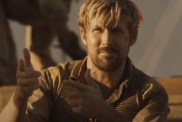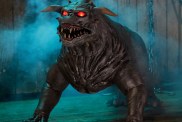
In addition to being one goddamn hell of a fine arts practitionerseriously go here and check out The Temple Series or Auto ImmuneDan Seagrave, as the gallery below surely attests, is also almost certainly the single greatest conceiver and executor of album cover art in the history of extreme musican incomparable visionary giant setting a resetting the bar for a quarter century now.
Considering Seagraves recent illustration gracing the cover of True Enemy, the sophomore release from rising SoCal death metal-infused metallic hardcore heroes Disgrace [ http://www.facebook.com/disgracehardcore ], is among his best, it seemed like an apropos moment to catch up with the legend, who graciously took the time to participate in a back and forth exchange via email last week.
But before we proceed here is some high praise for Seagrave from Disgrace frontman Taylor Young:
When we did [2012s debut full-length] Songs of Suffering I kind of hit up Dan as a long shot and when it actually worked out, it was just such a cool experience. Honestly, one of my biggest complaints about that first record is the cover is better than the record. So when he agreed to do True Enemy it was like, Okay, now weve got to sound as good as this cover looks. That was part of the goal. The amount of detail we give him is so minimal, and what he comes up with is just so fucking incredible.
Shock Till You Drop: This Disgrace cover is a very eerie, evocative piece. Can you tell me a little bit about where the initial idea came from and how it developed?
Dan Seagrave: This cover carries over from the one I made for Disgraces [debut LP] Songs of Suffering. Initially, my work begins with trying to get a sense of an albums theme, and to see if a band has any specific ideas. In this case, there was nothing definitive from Disgrace in terms of a visual I recall the bands lyrics dealt with anxiety. One line was, I will escape the ways of a life burnt down and rebuilt. Ill finally escape this guilt. I think that made me see both structural and psychological elements, which came out in that first cover. And the new album develops those themes into a wider landscape. To explain it literally, its a mechanical manifestation of the inner soulrepresented in this case by the visual form of human faces. From ancient Egypt to the present day, the human figure has been carved into stone. I find it interesting that humans need to represent themselves in that way to be considered great. Beneath the surface we are avoiding the inner selfthe part that really needs work.
So [in the piece] these great statue-like structures are now long eroded by time and we see that it was all just a facade. The actual fake representation of the power of humanity is stripped away to reveal its inevitable flaws as well as, ultimately, the decay and obsolescence of the body.
Here are a few lyrics from the song Uncreation that help me expand that theme: Internal peaks and valleys/Cerebral maze of twisted alleys. And, later: Greatness buried in the sand/Kingdom, the risen land.
I like these small excerpts. For me, even just a few words will open up a visual window.
Shock: Did they give you any guidance or was it free rein?
Seagrave: Id say there wasnt free rein exactly. I am still conscious of the fact that Im developing something for a band. Free rein is the domain of my personal art projects, where any strange and irrelevant thing can occur. Free rein to me is a complete anything goes and I dont think thats what people want [when they commission a cover] from me. It has to organically connect to the project, somehow. It is a collaborative venture. There are walls and certain parameters in a way, so I try to feed off that specific project outline and see what happens.
An example of an old cover that went astray is the piece I did for Edge of Sanitys The Spectral Sorrows. They gave me a photo of a waterfall and essentially wanted me to paint it. That seemed a bit boring. So I created something strange around it. Something irrelevant. In a way you could argue it was derivative of some surrealist imagery that Id been exposed to around then. It was a free flowing creation. I think people came to like it eventually, though I heard the band didnt care for it at the time.
With many of my cover works, unless the band has a very strict visual idea, Im left to use my imagination based on a theme or even just a title [and] then I am tapping into more of my own inner ideas and creative world more closely. So with this piece, Im getting more into ideas that are with me under the surface. Maybe a lot of these ideas actually would never otherwise get created down on paper if I didnt tap into that side of the brain. The album work does allow me to draw from the well.
Shock: The color scheme is a pretty interesting organic, state-of-decay kind of choice.
Seagrave: Unless a band has something in mind, I tend to gradually choose a palette. I like to let the painting evolve a bit, and not have everything mapped out. I may start out with one color and then glaze the painting up to a cooler tone. Sometime thats just not economical though. My pitch to the band, color-wise, was an Angkor Wat-type feelstone, weathered, ancient, abandoned. Grey-ish. Overcast. A green/mustard dingy cast light.
You can tell from that explanation that Im not definite about the color scheme.
Shock: Is there something about Disgrace that made working with them particularly attractive for you?
Seagrave: Certainly they have a great sound. They sent me tracks early on to check out. Thats always good to engage with. I also like that the band is a different strand of metal. I seemed to have worked with numerous offshoots of the metal genre and this has more of a hardcore edge.
Shock: Taylor told me the band felt as if they had to create music for this record that was worthy of your artwork.
Seagrave: Its not something Id heard, but thats very decent of him to say! I think everyone involved in projects similar to this one is trying to do the best they can with what time and resources they have. And the best resource where creative endeavors are concerned is wanting to do it and actually making something happen.
Shock: You’ve obviously been doing this a long time. Do ideas like the Disgrace cover continue to flow out of you? Or has the process gotten more difficult?
Seagrave: Im not short on ideas. I think as long as I can infuse my own inner self into these covers; and that people see that my work isn’t so straightforward; that there are some things that just happen away from the line work and design. Then the creative doors will remain open.
Seagrave Art
A look at some of the best work from seminal heavy metal artist, Dan Seagrave
-
Seagrave Art #1

Morbid Angel - Altars of Madness
-
Seagrave Art #2

Dismember - Like an Everflowing Stream
-
Seagrave Art #3

Entombed - Left Hand Path
-
Seagrave Art #4

Monstrosity - Imperial Doom
-
Seagrave Art #5

Pestilence - Testimony of the Ancients
-
Seagrave Art #6

Suffocation - Effigy of the Forgotten









